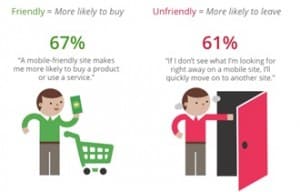You click on a search result.
The site loads but it’s completely unreadable on your mobile device.
The text is too small and the design is cluttered.
You click back to your search results in frustration.
Sound familiar? You’re not alone.
Usability is a critical aspect to web design.

Consumers are quick to get frustrated if a site fails to meet their expectations. Examples include pages that load too slowly or cluttered designs that make it difficult to navigate.
This also applies to web browsing on mobile devices.
A great mobile experience is a critical component of building a strong brand. And it starts with responsive web design.
What is Responsive Design?
 Responsive design is a layout that dynamically adjusts to fit various screen sizes. This creates an optimised browsing experience without having to create separate sites. Content displays correctly across all devices from desktops to smartphones and tablets.
Responsive design is a layout that dynamically adjusts to fit various screen sizes. This creates an optimised browsing experience without having to create separate sites. Content displays correctly across all devices from desktops to smartphones and tablets.
Why does this matter?
Because improved usability ultimately means more sales.
Here we take a closer look at responsive design and what it means for your business.
Higher Conversions
Mobile usage continues to see strong year over year growth.
Without a mobile-friendly site, users are more likely to bounce. A study from Google found that 61% of users were more likely to leave if they were unable to find what they were looking for on a mobile site. In contrast, 67% were more likely to make a purchase on a mobile-friendly site.
But does a responsive design translate to measurable results?
Absolutely.
Numerous case studies have already demonstrated that responsive design leads to higher conversions. What this means is your site could be losing sales without a mobile-friendly design.
Better Search Engine Optimisation
Responsive design is Google’s recommended configuration for building mobile-friendly sites. From an SEO standpoint, responsive design is incredibly beneficial for the following reasons:
- One URL: Desktop and mobile content is on a single URL. This makes it easier for Google’s algorithm to efficiently crawl and index all pages. It also eliminates the possibility of having duplicate content from a separate mobile site.
- Reduced bounce rate: Sites not optimised for mobile suffer from visitors quickly leaving. A mobile-friendly site helps to reduce bounce rate by keeping visitors engaged and navigating to other pages.
- Stronger link building: Because all content is contained on a single URL, you won’t have to worry about link dilution. This means that any links pointed to the desktop site also apply to the mobile counterpart, resulting in a stronger backlink profile.
- Improved mobile search rankings: Sites optimised for mobile rank higher than their non mobile-friendly counterparts for mobile search. This has far reaching implications especially for businesses with a local presence.
SEO is an important aspect of digital marketing. Responsive design drives engagement which contributes to higher rankings in the search results. This ultimately means more targeted traffic and sales.
Conclusion
An increasing amount of searches online are performed on mobile devices such as smartphones and tablets. Users won’t hesitate to leave if a site is not optimised for their device. Which means that mobile-friendly designs are absolutely critical.
Responsive design offers an elegant solution as it allows sites to automatically change for all devices whether a user is browsing from a desktop or smartphone. This translates to higher conversions and more targeted traffic through better SEO.
Written by Oliver Wood
